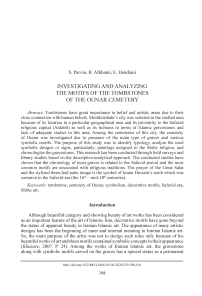Investigating and analyzing the motifs of the tombstones of the Ounar cemetery
Автор: Parvin S., Afkhami B., Hendiani E.
Журнал: Краткие сообщения Института археологии @ksia-iaran
Рубрика: Исследования в Центральной Азии
Статья в выпуске: 259, 2020 года.
Бесплатный доступ
Tombstones have great importance in belief and artistic areas due to their close connection with human beliefs. Meshkinshahr’s city was selected as the studied area because of its location in a particular geographical area and its proximity to the Safavid religious capital (Ardabil) as well as its richness in terms of Islamic gravestones and lack of adequate studies in this area. Among the cemeteries of this city, the cemetery of Ounar was investigated due to presence of the main type of graves and various symbolic motifs. The purpose of this study was to identify typology, analyze the used symbolic designs or signs, particularly, paintings assigned to the Shiite religion, and chronologize the gravestones. This research has been conducted through field surveys and library studies based on the descriptive-analytical approach. The conducted studies have shown that the chronology of most graves is related to the Safavid period and the most common motifs are associated with religious traditions. The prayer of the Great Salat and the stylized three-leaf palm image is the symbol of Imam Hussein’s tomb which was common in the Safavid era (the 16th - mid-18th centuries).
Tombstone, cemetery of ounar, symbolism, decorative motifs, safavid era, shiite art
Короткий адрес: https://sciup.org/143173128
IDR: 143173128
Список литературы Investigating and analyzing the motifs of the tombstones of the Ounar cemetery
- Afrouz M., 2014. Sign and Symbolism in Iranian Carpet. Tehran: Mardashti Cul-tural Center.
- Chevalier J., Gheerbranl A., 1999. Dictionary of Symbols / Transl. by Sudabeh Fathhali. First Printing. Tehran: Jeyhonon Publications.
- Cooper J. C., 2000. Illustrated Culture of Traditional Symbols / Transl. by Malihe Karbassian. Tehran: Nar Farhad.
- Dallasho M. L., 1985. Legendary mystic Language / Transl. by Jalal Sattari. Te-hran: Toos Publishing.
- Foladi M., Hassanpour M., 2015. The role of symbols and symbolism in human life: Sociological analysis // Journal of Cultural and Social Knowledge. Vol. 6. No. 4.
- Imamifar S. N., 2009. Applied Semiotics // Book of Moon Art. No. 135. P. 4-17.
- Jamshidi I., 2013. Symbol // Journal of Literature and Languages. The Growth of Persian Language and Literature Education. Spring 92. No. 105.
- Khazaee M., 2007. The imprint of symbolic motifs of Peacock and Simorgh in Sa-favid era buildings // Visual Arts. July, 26. P. 24-27.
- Motavali M., 2013. Study of the form and content in the designs of tombstones in the cemeteries of Mazandaran province (case study of tombstones of the cemetery of Chahsafid in Behshahr city): Master's thesis. Ministry of Science, Research and Technology, Payame Noor University, Payame Noor University of Tehran Province, Faculty of Arts and Architecture.
- Nobakhti Xiyavi S., 2001. Lost Xiyav from the history. Tehran: Ghoo Publication.
- Pahlavan F., 2006. An introduction to the Analysis of Elemental Images, Tehran: Art University.
- Peirce C. S., 1931-58. The Collected Papers. Vol. 2. Cambridge: Harvard.
- Pouriman Gh., 2001. Neginsabz of Azerbaijan (Meshginshahr). Tehran: Moshiri Publishing.
- Rismanchian O., HeidariM., 2005. "Water, Symbol, Desert": Scientific Confer-ence of Kavir Architecture Areas, Islamic Azad University of Ardestan.
- Sajjadi A., 1993. The series of evolution of the altar in the Islamic architecture of Iran from the beginning to the Mongol invasion: Master's thesis on archeol-ogy. Faculty of Humanities, Tarbiat Modarres University.
- Sajjadi J., 1996. Dictionary of mystical terms. Tehran: Iranian language and cul-ture.
- Shayestehfar M., 2009. Decorating the inscriptions of Sheikh Safi tombstones and adapting them to Naharkhoran of Gorgan // The Art Book Monthly. No. 134. P. 74-81.
- Shayestehfar M., 2010. Symbol of the basis of aesthetic and thematic studies of art // The Art Book sheet. No. 139. P. 94-109.
- Tafazoli A., 1997. Qibla of Mosque View, Mihrab // Islamic Studies Magazine. No. 35 and 36. Architecture Goljam. No. 12. P. 99-112.
- Widengren G., 1999. Religion of ancient Persia / Transl. by Manouchehr Farhangi. First Edition. Tehran.
- Yahaghi M. J., 1996. The Culture of Myths and Fictional refering in Persian Litera-ture. Tehran: Soroush.


